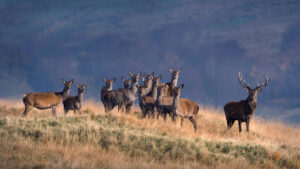ABOUT THE PAPER
During the deer’s breeding season, or rut, the researchers from Queen Mary University of London (QMUL) and ETH Zürich, played male fallow deer (bucks) in Petworth Park in West Sussex, a variety of different calls that had been digitally manipulated to change the pitch and length and analysed their responses.
Phys Org News-August 16, 2015
Pitcher et al – new research paper published in BMC Evolutionary
Research supported by BDS
The bucks treated lower pitched and longer calls as more threatening, by looking towards source of the call sooner and for longer, than others. Fallow bucks attracted the attention of the researchers because of their intriguing calling behaviour. Males are silent for most of the year, but call intensely for the brief period of the rut. Bucks pull their larynx towards their chest when they call, lengthening their vocal tract and deepening their calls. Bucks also call faster and have lower pitched calls than their larger cousins, red deer.
Larger and more dominant fallow bucks tend to make lower frequency calls. As animals become tired from competing for mates their calls become shorter and higher frequency. The researchers found that the bucks are able to hear subtle differences and make judgements about the level of competition they might face from the caller.
While humans would struggle to hear the differences in the deer’s calls, we do make judgements about each other based on the pitch of our voices. Studies cited by the researchers showed that men perceive others with lower voices as being more physically and socially dominant.
Dr Ben Pitcher, said:
“Deep calls help to beat other males in the quest for mates, and over generations competition between males for mates has driven the evolution of deeper, lower pitched and longer calls.
“Just like humans, fallow bucks can listen to the sounds of a rival’s voice and assess if they are dominant or pose a threat.”
Dr Alan McElligott, from QMUL and co-author of the study, said:
“This is the first time we’ve been able to see in experiments the importance of the pitch of calls to competition between males in a non-human mammal.
“The differences in call are subtle but they clearly mean a lot to the bucks that hear them. Bucks get into a lot of confrontations during the annual rut and being able to tell from a distance how big and how fresh another buck is might help them avoid being on the end of an unnecessary beating.”
FURTHER READING

From Local Action to National Impact: Reducing Deer Suffering After Road Collisions
After 15 years of dedicated work by the Hampshire and Isle of Wight Constabulary (HIOWC), together with essential support from Dorothy Ireland, Tony Lowry, and numerous volunteers from The British Deer Society (BDS) plus expert deer managers in Hampshire and surrounding counties, we are delighted to see the HIOWC Humane Animal Dispatch (HAD) volunteer scheme poised for a national rollout.

Support BDS and Help Protect Deer and Their Habitats
Discover how the British Deer Society is working to protect deer, their habitats, and promote sustainable wildlife management. Learn about our mission, vision, and how you can support deer welfare through education, research, and donations. Join us in making a difference for deer and the environment.

The Role of Deer Management in Conservation in the UK
Deer management plays a crucial role in supporting conservation efforts across the UK, helping to restore habitats, preserve biodiversity, and address the challenges posed by rising deer populations. This article explores the importance of balancing deer numbers with ecosystem health, highlighting the impact of culling, stakeholder collaboration, and holistic management strategies.










